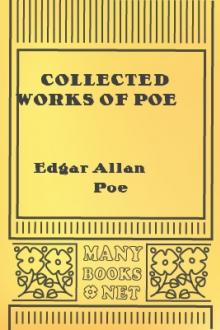Collected Works of Poe by Edgar Allan Poe (e reader TXT) 📕

- Author: Edgar Allan Poe
- Performer: -
Book online «Collected Works of Poe by Edgar Allan Poe (e reader TXT) 📕». Author Edgar Allan Poe
In this analysis of the operations of the Automaton, we have purposely avoided any allusion to the manner in which the partitions are shifted, and it will now be readily comprehended that this point is a matter of no importance, since, by mechanism within the ability of any common carpenter, it might be effected in an infinity of different ways, and since we have shown that, however performed, it is performed out of the view of the spectators. Our result is founded upon the following _observations _taken during frequent visits to the exhibition of Maelzel. {*5}
I. The moves of the Turk are not made at regular intervals of time, but accommodate themselves to the moves of the antagonist--although this point (of regularity) so important in all kinds of mechanical contrivance, might have been readily brought about by limiting the time allowed for the moves of the antagonist. For example, if this limit were three minutes, the moves of the Automaton might be made at any given intervals longer than three minutes. The fact then of irregularity, when regularity might have been so easily attained, goes to prove that regularity is unimportant to the action of the Automaton--in other words, that the Automaton is not a pure machine.
When the Automaton is about to move a piece, a distinct motion is observable just beneath the left shoulder, and which motion agitates in a slight degree, the drapery covering the front of the left shoulder. This motion invariably precedes, by about two seconds, the movement of the arm itself--and the arm never, in any instance, moves without this preparatory motion in the shoulder. Now let the antagonist move a piece, and let the corresponding move be made by Maelzel, as usual, upon the board of the Automaton. Then let the antagonist narrowly watch the Automaton, until he detect the preparatory motion in the shoulder. Immediately upon detecting this motion, and before the arm itself begins to move, let him withdraw his piece, as if perceiving an error in his manoeuvre. It will then be seen that the movement of the arm, which, in all other cases, immediately succeeds the motion in the shoulder, is withheld--is not made--although Maelzel has not yet performed, on the board of the Automaton, any move corresponding to the withdrawal of the antagonist. In this case, that the Automaton was about to move is evident--and that he did not move, was an effect plainly produced by the withdrawal of the antagonist, and without any intervention of Maelzel.This fact fully proves, ~--that the intervention of Maelzel, in performing the moves of the antagonist on the board of the Automaton, is not essential to the movements of the Automaton, 2--that its movements are regulated by _mind--_by some person who sees the board of the antagonist, 3--that its movements are not regulated by the mind of Maelzel, whose back was turned towards the antagonist at the withdrawal of his move.
The Automaton does not invariably win the game. Were the machine a pure machine this would not be the case--it would always win. The _principle _being discovered by which a machine can be made to _play _a game of chess, an extension of the same principle would enable it to win a game--a farther extension would enable it to win _all _games--that is, to beat any possible game of an antagonist. A little consideration will convince any one that the difficulty of making a machine beat all games, Is not in the least degree greater, as regards the principle of the operations necessary, than that of making it beat a single game. If then we regard the Chess-Player as a machine, we must suppose, (what is highly improbable,) that its inventor preferred leaving it incomplete to perfecting it-- a supposition rendered still more absurd, when we reflect that the leaving it incomplete would afford an argument against the possibility of its being a pure machine--the very argument we now adduce.
When the situation of the game is difficult or complex, we never perceive the Turk either shake his head or roll his eyes. It is only when his next move is obvious, or when the game is so circumstanced that to a man in the Automaton's place there would be no necessity for reflection. Now these peculiar movements of the head and eves are movements customary with persons engaged in meditation, and the ingenious Baron Kempelen would have adapted these movements (were the machine a pure machine) to occasions proper for their display--that is, to occasions of complexity. But the reverse is seen to be the case, and this reverse applies precisely to our supposition of a man in the interior. When engaged in meditation about the game he has no time to think of setting in motion the mechanism of the Automaton by which are moved the head and the eyes. When the game, however, is obvious, he has time to look about him, and, accordingly, we see the head shake and the eyes roll.
When the machine is rolled round to allow the spectators an examination of the back of the Turk, and when his drapery is lifted up and the doors in the trunk and thigh thrown open, the interior of the trunk is seen to be crowded with machinery. In scrutinizing this machinery while the Automaton was in motion, that is to say while the whole machine was moving on the castors, it appeared to us that certain portions of the mechanism changed their shape and position in a degree too great to be accounted for by the simple laws of perspective; and subsequent examinations convinced us that these undue alterations were attributable to mirrors in the interior of the trunk. The introduction of mirrors among the machinery could not have been intended to influence, in any degree, the machinery itself. Their operation, whatever that operation should prove to be, must necessarily have reference to the eve of the spectator. We at once concluded that these mirrors were so placed to multiply to the vision some few pieces of machinery within the trunk so as to give it the appearance of being crowded with mechanism. Now the direct inference from this is that the machine is not a pure machine. For if it were, the inventor, so far from wishing its mechanism to appear complex, and using deception for the purpose of giving it this appearance, would have been especially desirous of convincing those who witnessed his exhibition, of the _simplicity _of the means by which results so wonderful were brought about.
The external appearance, and, especially, the deportment of the Turk, are, when we consider them as imitations of _life, _but very indifferent imitations. The countenance evinces no ingenuity, and is surpassed, in its resemblance to the human face, by the very commonest of wax-works. The eyes roll unnaturally in the head, without any corresponding motions of the lids or brows. The arm, particularly, performs its operations in an exceedingly stiff, awkward, jerking, and rectangular manner. Now, all this is the result either of inability in Maelzel to do better, or of intentional neglect--accidental neglect being out of the question, when we consider that the whole time of the ingenious proprietor is occupied in the improvement of his machines. Most assuredly we must not refer the unlife-like appearances to inability--for all the rest of Maelzel's automata are evidence of his full ability to copy the motions and peculiarities of life with the most wonderful exactitude. The rope-dancers, for example, are inimitable. When the clown laughs, his lips, his eyes, his eye-brows, and eyelids--indeed, all the features of his countenance--are imbued with their appropriate expressions. In both him and his companion, every gesture is so entirely easy, and free from the semblance of artificiality, that, were it not for the diminutiveness of their size, and the fact of their being passed from one spectator to another previous to their exhibition on the rope, it would be difficult to convince any assemblage of persons that these wooden automata were not living creatures. We cannot, therefore, doubt Mr. Maelzel's ability, and we must necessarily suppose that he intentionally suffered his Chess Player to remain the same artificial and unnatural figure which Baron Kempelen (no doubt also through design) originally made it. What this design was it is not difficult to conceive. Were the Automaton life-like in its motions, the spectator would be more apt to attribute its operations to their true cause, (that is, to human agency within) than he is now, when the awkward and rectangular manoeuvres convey the idea of pure and unaided mechanism.
When, a short time previous to the commencement of the game, the Automaton is wound up by the exhibiter as usual, an ear in any degree accustomed to the sounds produced in winding up a system of machinery, will not fail to discover, instantaneously, that the axis turned by the key in the box of the Chess-Player, cannot possibly be connected with either a weight, a spring, or any system of machinery whatever. The inference here is the same as in our last observation. The winding up is inessential to the operations of the Automaton, and is performed with the design of exciting in the spectators the false idea of mechanism.
When the question is demanded explicitly of Maelzel-- "Is the Automaton a pure machine or not?" his reply is invariably the same--"I will say nothing about it." Now the notoriety of the Automaton, and the great curiosity it has every where excited, are owing more especially to the prevalent opinion that it is a pure machine, than to any other circumstance. Of course, then, it is the interest of the proprietor to represent it as a pure machine. And what more obvious, and more effectual method could there be of impressing the spectators with this desired idea, than a positive and explicit declaration to that effect? On the other hand, what more obvious and effectual method could there be of exciting a disbelief in the Automaton's being a pure machine, than by withholding such explicit declaration? For, people will naturally reason thus,--It is Maelzel's interest to represent this thing a pure machine--he refuses to do so, directly, in words, although he does not scruple, and is evidently anxious to do so, indirectly by actions--were it actually what he wishes to represent it by actions, he would gladly avail himself of the more direct testimony of words--the inference is, that a consciousness of its not being a pure machine, is the reason of his silence--his actions cannot implicate him in a falsehood--his words may.
When, in exhibiting the interior of the box, Maelzel has thrown open the door No. I, and also the door immediately behind it, he holds a lighted candle at the back door (as mentioned above) and moves the entire machine to and fro with a view of convincing the company that the cupboard No. 1 is entirely filled with machinery. When the machine is thus moved about, it will be apparent to any careful observer, that whereas that portion of the machinery near the front door No. 1, is perfectly steady and unwavering, the portion farther within fluctuates, in a very slight degree, with the movements of the machine. This circumstance first aroused in us the





Comments (0)